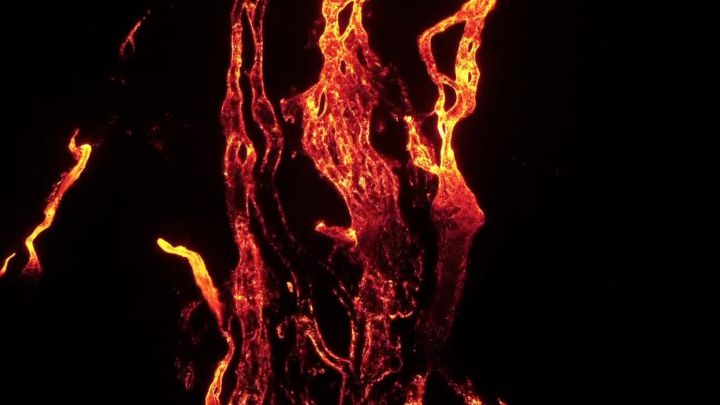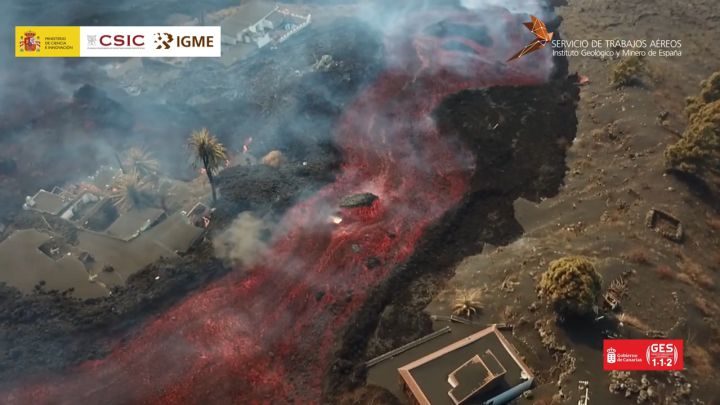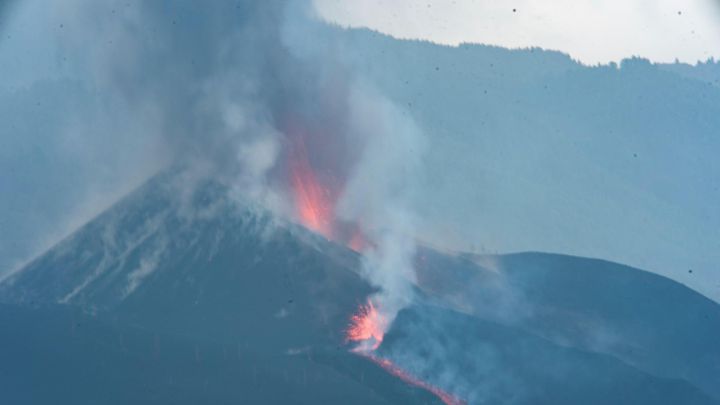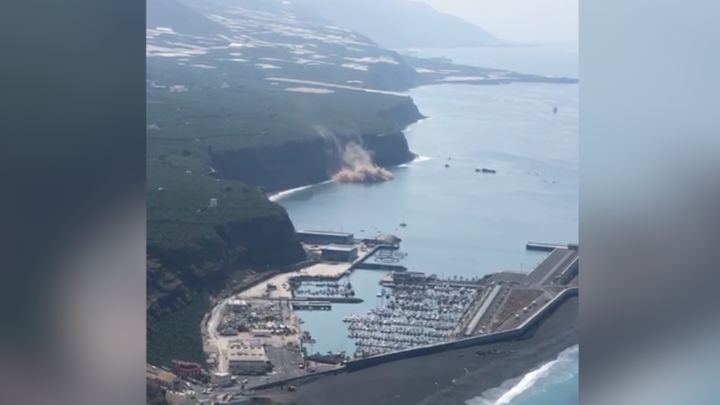La Palma volcano eruption summary: 20 October 2021
Information and updates on the eruption of the Cumbre Vieja volcano on La Palma, the most important on the island since 1585.
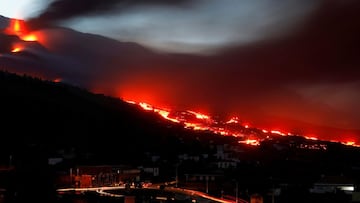
Show key events only
La Palma volcano eruption: live updates
Headlines
- Volcanic activity enters 31st day on Wednesday, having begun on 19 September
- More than 600 tremors were registered in La Palma in the last week, according to Spain's Instituto Geográfico Nacional
- Strongest earthquake registered on Tuesday night, 4.8 magnitude
- Lava flow now covers surface area of 811.8 hectares according to Copernicus radar imaging, with 22.2 hectares added in just seven hours
- 35,000 earthquakes and tremors recorded in La Palma during the past month
- Nearly 2,000 buildings destroyed by lava flow
- Cumbre Vieja eruption the "most important since 1585", according to Copernicus
- No short or medium term end to eruption claim experts, as more La Palma residents forced to evacuate
- Lava forming huge delta on La Palma coast
- Delta has claimed around 40 hectares of new land from the Atlantic
Useful information
- Volcanologist speaks to AS about the effects of lava reaching the sea
- An overview of the active volcanoes on the Canary Islands
- When was the last volcanic eruption on the Canary Islands?
La Palma residents shield themselves from volcanic debris
One month after the Cumbre Vieja volcano first erupted and residents of the Spanish island of La Palma are still forced to adapt to the ongoing eruptions that have seen a large proportion of the island evacuated. In this clip from CBS Baltimore, residents can be seen sheltering under umbrellas.

Francisco Ramos, who was evacuated one month ago from his house, looks at the state of his home from a lookout on Wednesday as the Cumbre Vieja volcano continues to erupt on La Palma.
(Photo: REUTERS/Susana Vera)
Where are most volcanoes located?
Volcanism is responsible for over 80 percent of Earth’s surface both above and below sea level, but where are the most volcanoes located today?
Several areas evacuated
Pevolca, the Canary Islands' volcano emergency response body, has ordered the evacuation of a number of areas: Las Martelas in the municipality of Los Llanos de Aridane, and Marina Alta, Marina Baja, La Condesa and Cuesta Zapata in the municipality of Tazacorte.
Eye-catching images of the Cumbre Vieja eruption
This video filmed on La Palma on Wednesday evening shows some striking images of the lava flowing from the Cumbre Vieja volcano:

Spanish Civil Guards check who enters an evacuated area at a checkpoint at El Charco on Wednesday, as the Cumbre Vieja volcano continues to erupt on La Palma.
(Photo: REUTERS/Susana Vera)
Copernicus to turn to radar imagery after clouds again foil update
Copernicus, the EU satellite observation programme that has been offering updates on the size of the Cumbre Vieja lava flow and the damage it has caused on La Palma, was again unable to get a clear picture of the eruption with optical imagery, due to cloud cover over the Canary Island.
However, it says it will instead use radar imagery to provide its 26th update.
Involcan video of Cumbre Vieja eruption
The Canary Islands Volcanology Institute has also posted this video of the ongoing eruption of the Cumbre Vieja volcano, at 7:45pm local time on Wednesday evening.
Involcan images of La Laguna
These images of the lava flow's advance into La Laguna were captured by the Canary Islands Volcanology Institute (Involcan) earlier on Wednesday:
Eruption "completely overwhelming" fire fighters
Fire fighters on La Palma have released a video of the advance of the lava flow in La Laguna, in a tweet in which they speak plainly about the difficulties they're facing as they battle the effects of the Cumbre Vieja eruption.
“The situation on the island of La Palma is completely overwhelming us and showing us that nothing can prepare you for this,” the Gran Canaria Fire Service said.
“Nevertheless, we’ll go on being there because it hurts us as much as it does the people of La Palma.”
Lava flow reaches the centre of La Laguna
Video images of La Laguna, located in the municipality of Llanos de Aridane, where the advancing lava flow has destroyed a number of buildings.

The Cumbre Vieja volcano spews lava on Wednesday as it continues to erupt on La Palma, as seen from Tijarafe.
(Photo: REUTERS/Susana Vera)
Satellite images of La Palma from earlier in October are released
While the reporting can make it seem that the lava has reached every corner of the island, it is in reality confined to one part. However, with new mouths continuing to emerge, the direction of the lava flow could change quite rapidly.
A new mouth in the volcano in La Palma emerged on Tuesday night
This just the newest of many mouths that have emerged since the eruption began more than a month ago. CBS News has shared images of the new mouth captured shortly after it formed.
When will the volcanic eruption on La Palma end?
Spanish authorities have announced today that they are unable to determine when the disaster will end.
Last Friday, cameras captured a large lava rock flowing down a river of lava which as not let up in recent days. The eruption has been going on for more than a month, and some experts project that the episode may not end until December of this year.
Increase in domestic violence since La Palma eruption
The heads of Social Services of the Canary Islands and La Palma along with the Director of Equality Institute for the regional government informed of the measures being taken to tackle a rise in domestic violence since the Cumbre Vieja volcano began erupting. There has been a 60 percent uptick in the number of women calling for assistance in the month since the natural disaster started.
The regional government has approved $500,000 Euros to aid with the situation. The bulk of that money will go to providing shelter for those suffering domestic violence.
Mónica Fumero Purriños, Director of the Instituto de Igualidad Canario said "No minor, no woman will be left out. Everyone will have a roof over their head."
A view from above of the four Cumbre Vieja vents
Aerial footage taken over the four vents of the Cumbre Vieja volcano on La Palma give a closer look at the different activity taking place in each one. Three of the four vents are located higher up on the mountain are more explosive, emmitting gases and pyroclasts.
The vent on the northeast slope lower down is where the bulk of the lava is flowing out of.
La Palma eruption raining volcanic ash
Residents of La Palma have endured four-plus weeks of ash ejected from the Cumbre Vieja volcano falling from the sky. Carrying an umbrella to protect themselves from the grains of volcanic material has become a daily habit.
The ash could destroy up to 15 percent of the island's banana crop as well as around a third of a local saltwork's production.
Drones to rescue dogs trapped by lava flow
Aerocamaras, a drone company, has received permission to attempt a rescue mission. Three or four dogs are stranded by the lava that began flowing down Cumbre Vieja toward the sea 19 September and now covers over 800 hectares.
Drones have been used to bring the animals food and water but this mission will be more diffcult. The operators will need to net the dogs within eight minutes in order to have enough battery power to carry them over the lava field.
Did you feel the earthquake?
The Spanish National Geographic Institute is asking residents of La Palma and other parts of the Canary Islands archipelago if they felt last night's 4.8 magnitude eathquake with an epicenter near the Cumbre Vieja eruption.
Eruption on La Palma passes one-month marker
When Cumbre Vieja roared to life on 19 September it wasn't expected to last long, but four weeks later no one is certain when it will end.
A comparison of the Cumbre Vieja eruption with previous eruptions
The Cumbre Vieja eruption has spewed more lava than the previous four recorded eruptions on the west side of La Palma. The graphic provides a side-by-side look at past eruptions since the 16th Century.
La Palma awakes to 31st day of Cumbre Vieja eruption
Cumbre Vieja began ejecting molten rock on 19 September and has no ceased for 31 days with no end in sight. A new stream of lava is progressing toward the sea appraoching at around 5 meters per hour during the night with estimates ranging from 30 to 80 meters to go. Once it reaches the water new explosions are expected as the molten rock mixes with the saltwater.
The local government provides a view this morning of the situation on the ground.
Cloud cover scuppers Copernicus update
Copernicus, the EU's satellite observation programme, was unable to provide its latest update on the extent of the Cumbre Vieja lava flow late on Tuesday, as cloud cover was obscuring the view in the most recent image taken.
"We cannot risk predicting anything"
One month after the Cumbre Vieja volcano erupted on the Spanish island of La Palma spewing red-hot lava and ash, Culberta Cruz, her husband and their dog are living in a tiny caravan on a parking lot and see no end of the ordeal in sight.
"I'm tired, so tired ... but who are we to fight against nature?," the 56-year-old hospital kitchen worker said, sitting on a camping chair.
Her husband, banana grower Tono Gonzalez, was pulling electric cables and water hoses to connect to the vehicle, with their French bulldog looking on. The couple have been living in the small camping car for a month, constantly brushing off volcanic ash from the vehicle.
"One day it's exploding there, the other a vent opens here, it's just anguish and living in fear, waiting and praying for it to stop erupting," Cruz said. "And it's a lot of sadness for those who lost their homes."
Streams of red-hot lava have engulfed almost 800 hectares (2000 acres) of land, destroying about 2,000 buildings and many banana plantations since the eruption started on Sept. 19. More than 6,000 people have had to leave their homes.
Carmen del Fresno, from the National Geographic Institute's volcano monitoring department, told Reuters the eruption is unlikely to stop for at least another week, but there was no way to predict how long it would last.
"Historical records show eruptions lasting 24 to 84 days... It would be logical to assume something within those bounds, but we cannot risk (predicting) anything."
Where are most volcanoes located?
Volcanism is responsible for over 80 percent of Earth’s surface both above and below sea level, but where are the most volcanoes located today?

La Palma eruption "the most important since 1585"
According to Copernicus, the EU's satellite observation programme, the ongoing eruption of the Cumbre Vieja volcano has become the most significant volcanic eruption witnessed in almost 450 years, since 1585.
Photo: Miguel Calero/EFE
Cumbre Vieja has caused unparalleled damage
Of all of the volcanic erruptions that have been recorded on La Palma, none have caused as much damage as the Cumbre Vieja erruption which began on 19 September. Lava from the volcano has so far engulfed 811.8 hectares of the island - almost double the 441 hectares of land which the El Charco erruption of 1712 destroyed.
La Palma volcano eruption updates: welcome
Hello and welcome to our live blog for Wednesday 20 October 2021, bringing you the latest updates and information on the eruption of the Cumbre Vieja volcano on La Palma.
Many believed it would be short lived when the lava first began flowing way back on 19 September. As we now know, that prediction was a long way from what has transpired since.
